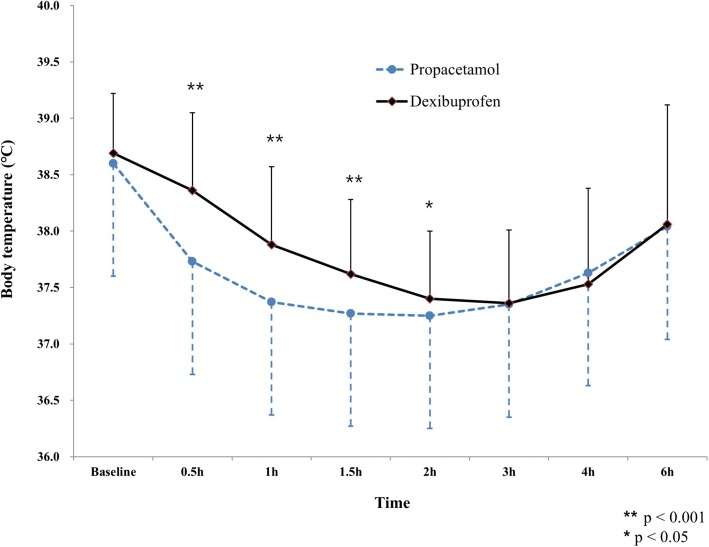No child's play: a comparison of two antipyretics

Fever as an indicator:
One of the oldest indicators of illness in mammals, fever is one of the most common reasons for doctor visits worldwide. Fever is often noticeable as a reaction to inflammation, infection and trauma. In addition to a rise in body temperature, fever often manifests with other illness behaviors. This is exactly why it is important to know which type of medication to use (e.g.: intravenous, rectal or oral). Because if the child is experiencing respiratory distress or vomiting, for example, rectal or intravenous administration would be an alternative.
Ethical Standard:
All procedures in the multicenter, randomized, double-blind, comparative phase 3 clinical trial recently published in the journal BMC Pediatrics were conducted in accordance with institutional and/or national research committee ethical standards. In this study, patients aged 6 months to 14 years with axillary (in the axilla) body temperature greater than 38°C were assigned to the study group or control group.
Method and Procedure of the Study:
The study group was first given intravenous propacetamol followed by oral placebo medication. Patients in the control group were infused intravenously with 100ml of 0.9% sodium chloride solution without propacetamol. Then oral dexibuprofen was administered. Body temperature of all patients was measured after 0.5, 1, 1.5, 2, 3, 4 and 6 hours from oral placebo or dexibuprofen. No other antipyretics or antibiotics were administered within 6 hours of placebo or dexibuprofen administration unless deemed necessary by the treating pediatrician.
A total of 263 patients (125 in the study group) from Catholic University of Korea Hospitals were enrolled. Body temperatures of patients in the study group were significantly lower (37.73°C versus 38.36°C and 37.25°C versus 37.40°C at 0.5 and 2 hours, respectively) until two hours after administration.

The temperatures in the period 3, 4 and 6 h after administration of the drugs did not differ significantly. A body temperature of less than 38 °C was reached within 0.5 h after administration of propacetamol, while it took approximately one hour to reach the aforementioned body temperature after administration of dexibuprofen. The two groups showed no significant differences in terms of range of body temperature decrease, range of body temperature change for antipyretic administration-time relationship, maximum value of body temperature decrease during the 6-hThe range of body temperature change for fever-reducing administration-time relationship, the maximum value of body temperature decrease during the 6-hour test period, the number of patients (whose body temperature normalized), the mean time at first normalization of body temperature, and the development of adverse events including gastrointestinal problems, elevated liver enzymes, and low platelets (e.g., nosebleeds).e.g., nosebleeds)
Physical examinations and laboratory tests (with complete blood cell count, blood chemistry analysis, and urinalysis) were performed prior to antipyretic administration and at the second visit (3 days after initial administration). Adverse events were monitored throughout and all occurrences were recorded.
Study Results:
Based on the study results, the antipyretic effect of intravenous propacetamol compared to oral dexibuprofen was found to be similar in the patients with fever at 6 hours. Further, the body temperature values of the former were significantly lower than those of dexibuprofen in the first two hours. While the drug concentration of propacetamol (intravenous administration) reaches the maximum value within 40 minutes, it takes more than two hours for dexibuprofen (oral administration) to reach its highest concentration.
Conclusion:
Dexibuprofen (contained, for example, in Seractil forte film-coated tablets) and propacetamol (contained, for example, in ben-u-ron suppositories) are the two most commonly used antipyretics (i.e., antipyretic drugs) in children and adolescents. In cases where the oral route is not possible, propacetamol can also be used through a rectal route. Especially in those cases where the child suffers from respiratory distress or vomiting, this route of administration would be an option. In such a case, however, the bioavailability, i.e. the part of the administered dose that reaches the circulation, would be significantly reduced (54% less than the oral route). This is why it is of utmost importance to weigh up whether to use intravenous, rectal or oral administration.
Sources
- Choi SJ, Moon S, Choi UY, Chun YH, Lee JH, Rhim JW, Lee J, Kim HM, Jeong DC (2018): The antipyretic efficacy and safety of propacetamol compared with dexibuprofen in febrile children: a multicenter, randomized, double-blind, comparative, phase 3 clinical trial, BMC Pediatr.
- Dimie Ogoina (2011): Fever, fever patterns and diseases called ‘fever’ —A review, Band 4, 3. Ausgabe, King Saud Bin Abdulaziz University for Health Science, Nigeria: Journal of Infection and Public Health.
- Thrombozytopenie (Netdoktor)
- Medikamente zur Fiebersenkung (Apotheken.de)
- Bioavailability (Sciencedirect)

Danilo Glisic
Last updated on 02.12.2020
Your personal medication assistant
Browse our extensive database of medications from A-Z, including effects, side effects, and dosage.
All active ingredients with their effects, applications, and side effects, as well as the medications they are contained in.
Symptoms, causes, and treatments for common diseases and injuries.
The presented content does not replace the original package insert of the medication, especially regarding the dosage and effects of individual products. We cannot assume liability for the accuracy of the data, as the data has been partially converted automatically. Always consult a doctor for diagnoses and other health-related questions.
© medikamio